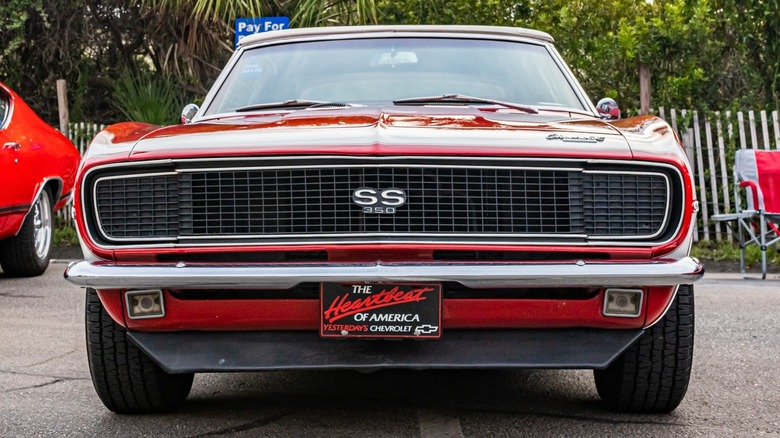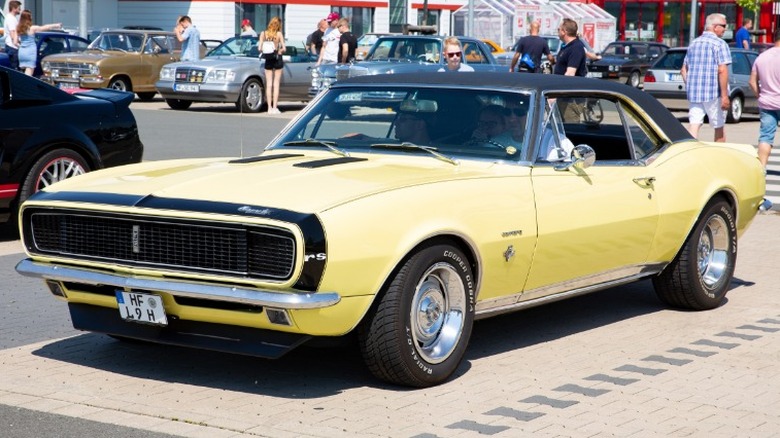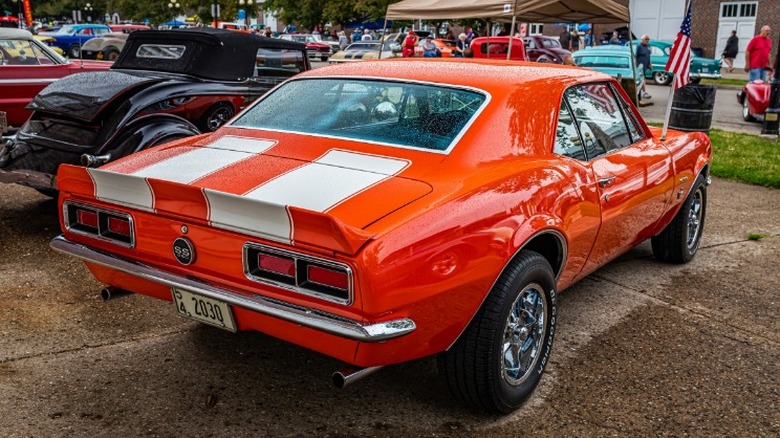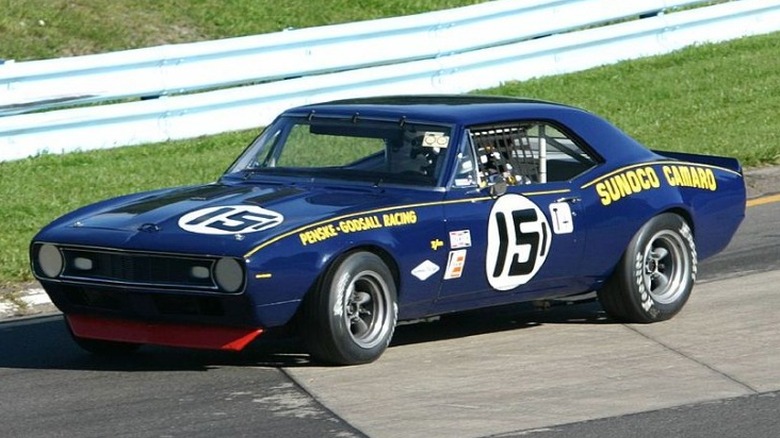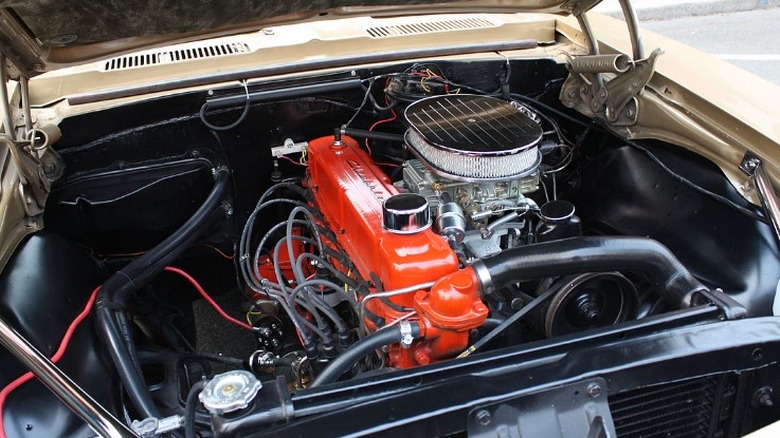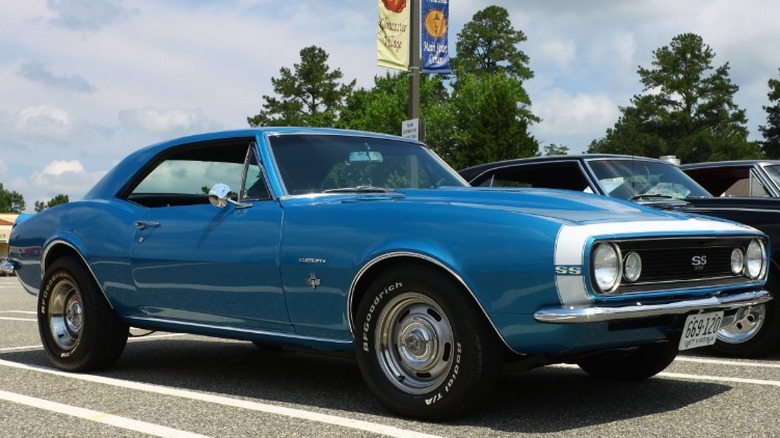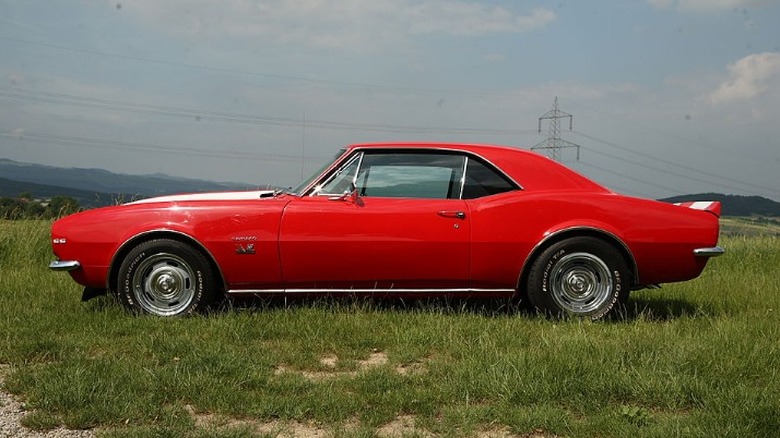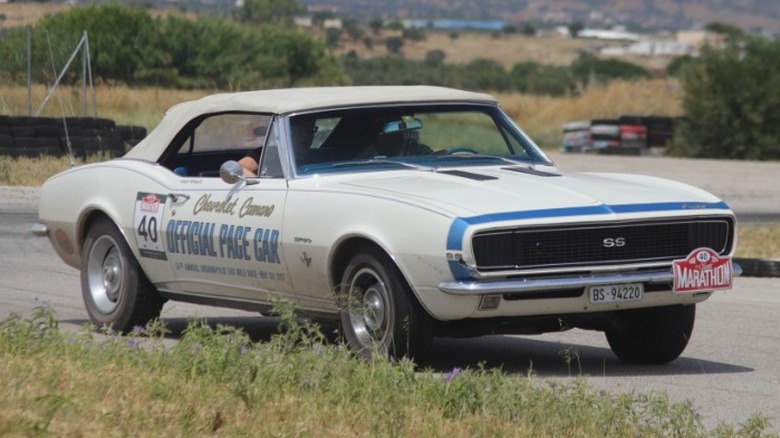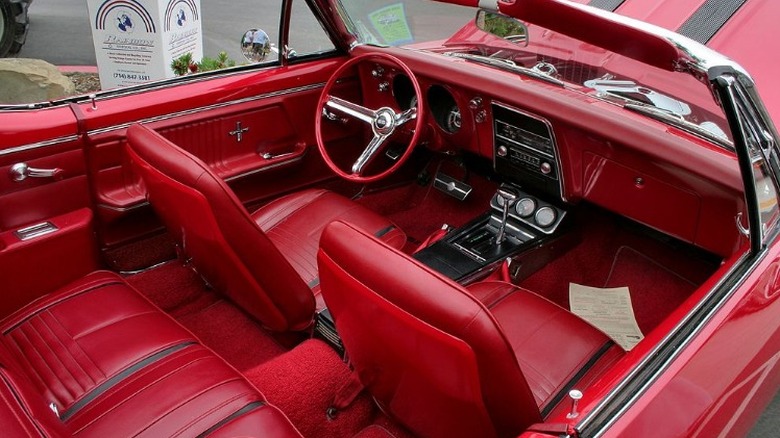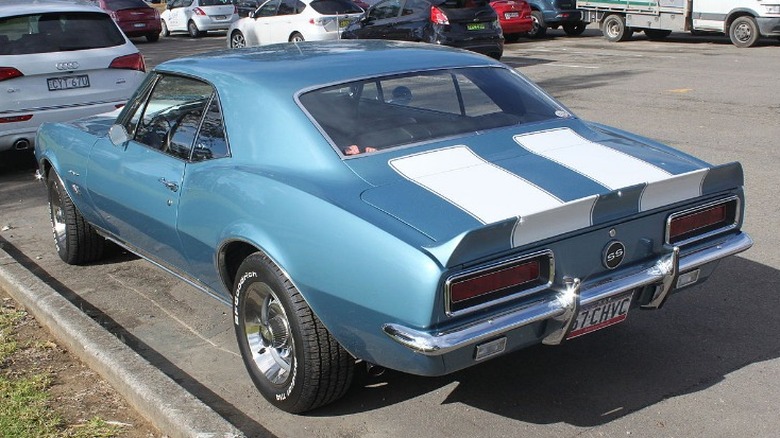Facts Every Car Fan Should Know About The 1967 Chevy Camaro
In 1967, Chevrolet unleashed its pony car on the public, creating an automotive legend that would endure, with a short hiatus, until today. It came out at a time when manufacturers were in an unofficial horsepower war, with each company raising the level of brinksmanship through the release of increasingly larger and more powerful engines. A decade before, only a few choice model cars received engines rated at 300 or more horsepower, but, by 1967, 300 had begun to be almost commonplace. Furthermore, large displacement engines, sometimes known as big blocks, started showing up in high-performance models with a lot of horsepower and a huge amount of torque.
While the Camaro shared many characteristics of the Mustang, it was still a completely unique car that has since garnered a loyal fan base. Shortly after showing up in dealer showrooms, Camaros also showed up on the track, proving to be capable race cars, winning many checkered flags in its first year out, often beating rivals from Ford and Chrysler. It helped that 1967 was also a good year for sports car development since it preceded the days of adhering to federal guidelines for emissions and safety. While automakers have come a long way since then, the cars of the late '60s, such as the '67 Camaro, are fine examples of what they could do with a pencil and a slide rule in creating an excellent automobile. Though most gearheads likely know plenty about the 1967 Camaro, these are some facts every fan of the car should know.
Its design was tightly constrained
Ford caught the competition off guard when it debuted the Mustang. The only thing Chevrolet had to compete with it was the Corvair. While it was a fun car and had a lot going for it, it would never go toe to toe with Ford's new coupe. Plans to develop a sporty car had been set in motion by August 1964, according to Hemmings. Chevrolet's designers were pleased with the announcement and were eager to get started. However, there would be some parameters they had to work with as the new car would coincide with the upcoming Chevy II and would also share the platform and some components.
The limitations in design came from the need to keep costs down as the Camaro would be a sports car with lower sales volume than the Chevy II, which would be a high-volume money maker. For the new car, the height of the cowl and the distance from the dash to the front axle were both dimensions designers were unenthusiastic about. Otherwise, talented designers took what they had to work with and set about creating something new. The car ended up being a striking vehicle with a timeless design. GM's chief designer, Bill Mitchell, said boldly that he favored the second generation Camaro, saying it was "a designer's design; but that first series was designed by committee."
A response to Ford
As previously mentioned, the Corvair was Chevrolet's sporty car from 1960 and it sold well, spawning several variants including coupe, sedan, wagon, truck, and van. The only dedicated sports car was the Corvette, which was an all-out high-performance coupe that sold for a premium. Ford's Mustang established a completely new class of car, the pony car, and Chevrolet needed a response. To illustrate how urgently GM felt the need to respond with its own car, the Ford Mustang debuted in April of 1964, and plans for the Camaro had been started by August of that year.
While the car was an obvious response to Ford, Chevrolet may have wanted to put on a different public face. In a promotional video from the company posted by Mac's Motor City Garage, the narrator and a few GM personnel describe the design process, mentioning that plans began in early 1964, with ideas for a new four-passenger coupe originating before then as if to say this car was an original idea from the start. Then, around the middle of the film, while discussing the curved and aerodynamic shape of the car, it is contrasted to "the flatter slab-sided look, or the squared-off boxy look," which could be construed as a jab to the Mustang, which features vertical sides and more sharp angles and straight lines throughout. Although the Camaro turned out to be a good response to the Mustang, Chevrolet moved 220,906 units compared to Mustang's 472,121, per Car and Driver. It would be a decade before Camaro managed to outsell Mustang in a single year.
Z/28 was built to race
Auto racing had been an integral part of manufacturing and selling cars from the start. Founders of early car companies would be the same men who built the cars and also raced them. Wins on the track would be used to promote sales in the showroom. This practice continued into the corporate world of auto manufacturing until GM initiated a ban on motorsport competition for all divisions for a variety of reasons in 1963. Overnight, this left Pontiac and Chevrolet with high-performance programs dead in the water. But it did not stop their cars from racing.
Just before the Camaro debuted, the SCCA created the Trans-Am sedan racing class, which would allow the Camaro to compete. Despite GM's official policy of not sponsoring any race teams, engineer Vince Piggin oversaw the development of a special edition Camaro that would qualify for the sedan class. According to MotorTrend, Piggins developed a car with heavy-duty suspension, disc brakes, and a 283-cubic-inch engine, as the rules stipulated a maximum size of 5.0-liters (305 cubic inches). Chevrolet general manager Pete Estes suggested taking the 283 crankshaft and installing it into a 350 block, which yielded a displacement of 302 cubic inches, which came in under the limit and the Z/28 was born. The Z/28 packages could also be ordered with cowl induction hood, exhaust headers, and a rear spoiler. Despite not sponsoring any race cars, Chevrolet had created and delivered the car that would win the 1968 and 1969 Trans-Am Championships.
[Featured image by via Nathan Bittinger via Wikimedia Commons | Cropped and scaled | CC BY 2.0]
Six engine choices for 1967
Today, the Camaros of legend and desire are the horsepower-heavy street machines that can lay down trails of rubber and smoke before tearing down the street. Yet the Camaro was built to be sold to the masses and not everyone could afford a giant engine, nor did they want one. For many new car buyers, having a car that looked good and drove well was good enough. For these customers, a 230-cubic-inch inline-6 or 250 inline-6 turbo thrift was available. According to Z28.com, around 58,000 units had these engines and the rest were V8.
Four V8 engines made up the remaining 150,000 or so Camaros that left the factory that year, per Automobile Catalog. The 327 V8 had been the standard Chevy V8 since the late '50s, and, in the Camaro, it turned out up to 275 horsepower. The 350 was a new engine for Chevrolet, and it delivered a healthy 295 horsepower, while the largest 396-cubic-inch big block, raised power to 375. The years 1967 to 1969 were the only ones in which Chevrolet offered an engine with a 302-cubic-inch displacement, and it went in the Z/28. While it produced 290 horsepower, which was less than other options, its short stroke allowed it to rev high and that is part of what helped it win races.
[Featured image by Nick Ares via Wikimedia Commons | Cropped and scaled | CC BY 2.0]
Option packages
Many car models come out with a couple of configurations available, and special editions and option packages are offered in subsequent years, perhaps after evaluating the success of it. With Camaro, it came out of the gate in several flavors. The base model came in coupe or convertible and could be had with a 6-cylinder or V8. Buyers could step up from there to the RS, SS, and Z/28 models.
The RS model, or Rally Sport, according to Muscle Car Facts, was an appearance package that could be had with any engine and transmission combination. It included hideaway headlights, side moldings, stylized RS emblems, and unique tail lights. RS sales accounted for about 64,842 cars. The most powerful was the SS, or Super Sport, and it came with a choice of a 295 horsepower 350 V8, or the monster 396 big block with either 325 or 375 horsepower. It included SS emblems, a unique bumble bee stripe running across the nose of the car, and faux air intakes on the hood. This represents about 34,411 units in 1967. The rarest option is the Z/28, of which only 602 were built. It was not the most powerful, but was tuned for racing and is competent on the track.
Collectible first-year Camaros
All of the first generation Camaros have become coveted by collectors and gearheads in general. With sales coming in around half of the Mustang sales in the same year, they are now much harder to find, especially the RS, SS, and Z/28 in particular.
Compared to some collector cars, Camaros could be considered reasonable. Results from Bring a Trailer show that cars that are all original and unrestored get the highest bids, with an average in the $40,000 to $50,000 range. Tastefully modified versions with custom paint or engine swaps tend to sell in the $30,000 range and other very nice examples can be had for around $20,000. In 2021, a white Z/28 sold at Barrett-Jackson for $220,000, and another Marina Blue car sold in 2022 at Mecum for $195,000.
[Featured image by Rudolf Periny via Wikimedia Commons | Cropped and scaled | Public domain]
Official Pace Cars
While GM had no official sponsorship of any racing team, nor did the company field any cars in any races, it still used the sport for brand promotion. From its early days, the Indianapolis 500 auto race featured a production car to lead the field of racers in one to three laps of the track before the participants were given a signal to start the race from a rolling start at a given speed. It has been an opportunity for manufacturers to showcase new cars in front of crowds and on TV (via Motorsport.com).
GM has had its cars featured for decades as pace cars with more recent cars driven by the likes of Jay Leno, Chuck Yeager, Morgan Freeman, and James Garner. In 1967, Chevrolet was chosen to lead the pack with the new Camaro convertible. The cars prepped for the race were white with a blue interior in SS trim. They featured the 396 V8 with 375 horsepower and a four-speed transmission, per MotorTrend. While the Z/28 model was highly limited, the Indy Pace Car edition is more so. GM Authority reprts that four cars were produced to be used at the race and 100 more were made for promotional purposes, and, in 2022, one of them went up for auction at Mecum, bringing in an astounding $632,500.
Unique features
When looking at classic cars, it can sometimes be challenging to identify them without being immersed in the model's history. Sometimes small things can denote what year one car is from another, and debut models often have differences from cars that came later on. With the 1967 model, at least one identifying feature is in between the front seats. This might not be all too interesting except that it is one of the coolest center consoles of the era, and it only shows up in 1967 models. This year model console sits low and flat between the seats and extends to the rear passenger area, and it includes round, triple-dial auxiliary gauges up front, which gives the car a genuine race car feel.
First-year Camaros have a few other distinguishing features to help spot them among the crown. Side marker lights were added in 1968 to the front and rear, leaving the '67 with clean sheet metal lines front to back. The '67 models have a vent window that was dropped the next year and the turn signals in the grill started round and were made square in '68. All the first gen Camaros share the same body and chassis but have some minor and more significant changes between them and a great guide to spotting them is listed on the Champion Cooling blog for more info.
[Featured image by Rex Gray via Wikimedia Commons | Cropped and scaled | CC BY 2.0]
Camaro debuted the small block 350
Most car enthusiasts, especially fans of Chevy, know that the small-block 350 seemed like it was the engine that powered the world for a time. Once parts sharing across GM brands became the norm, the 350 was found in dozens of cars from Buick to Pontiac as well as Chevrolet. It was put in trucks, boats, and probably military equipment also. However, it was not always so ubiquitous. After its introduction in the '50s, the Chevy small block was largely produced in either 283 or 327-cubic-inch displacement (via MotorTrend).
The year 1967 marks the debut of the small block 350 in the Camaro. Not only was it first offered that year, but the Camaro was also the only car in which it was offered. Even the Corvette had to wait until 1969 for its small block to increase in size. While the Corvette offered four V8 engine options in 1967, the 350 would reign from 1970 until the LS arrived.
[Featured image by Jeremy via Wikimedia Commons | Cropped and scaled | CC BY 2.0]
